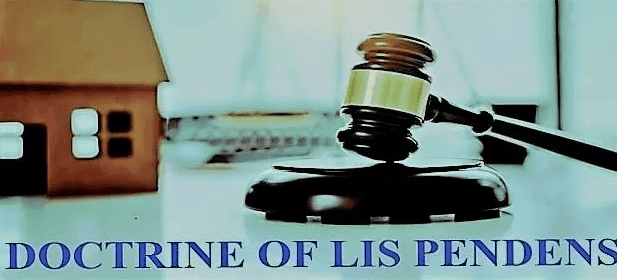The Transfer of Property Act | Civil Law for Judiciary Exams PDF Download
Doctrine of Holding Out
Doctrine of Holding Out in Property Law

- The Transfer of Property Act, 1882 (TPA) includes the doctrine of holding out in Section 41 and Section 43.
- These sections protect individuals who act in good faith in property transfers.
Transfer by Ostensible Owner
- Defined in Section 41, this doctrine is an exception to the principle nemo dat quod non habet (no one can transfer a better title than they possess).
According to Section 41:
- If a person (the ostensible owner) has the consent of the real owner to manage the property, they can transfer it for consideration.
- The transfer cannot be declared void simply because the transferor wasn't authorized.
- The transferee must act in good faith and make reasonable efforts to confirm that the transferor can make the transfer.
The requirements for this transfer include:
- The transfer must be made by an ostensible owner.
- The ostensible owner must have consent from the real owner.
- The transfer must involve consideration (something of value).
- The transferee must act in good faith and with reasonable care.
Who is an Ostensible Owner?
- An ostensible owner appears to be the true owner based on the circumstances, and the real owner does not correct this impression.
- This doctrine protects a buyer (transferee) when they purchase from someone who seems to be the owner.
Landmark Case: Ram Coomar v. MacQueen (1872):
- This case established that if a person allows another to present themselves as the owner of property, a buyer acting in good faith cannot be denied ownership later.
Benami Transactions (Prohibition) Act, 1988:
- The Benami Transactions Act aims to prevent hiding property under another person's name, often to avoid creditors.
- Section 3 of this act prohibits such transactions, while Section 41 of the TPA allows transfers by ostensible owners.
- Thus, transfers under Section 41 must still comply with the Benami Transactions Act.
Holding Out Under Section 43:
- Section 43 is also known as the doctrine of feeding the grant by estoppel.
- This section applies when someone falsely claims they can transfer property.
- It allows the transfer to affect any interest the transferor gains in the property during the contract period.
- Transferees acting in good faith are protected, even if they were unaware of the transferor's misrepresentation.
Landmark Case: Jumma Masjid v. Kodimaniandra Deviah (1962):
- This case clarified that if someone transfers property claiming to have a direct interest (when they only have a future interest), Section 43 still protects the transferee.
Conclusion
- The doctrines in Sections 41 and 43 of the TPA aim to safeguard the interests of parties who act in good faith during property transactions.
Doctrine of Part Performance

- The Doctrine of Part Performance is an important part of property law under the Transfer of Property Act, 1882 (TPA).
- It allows for the recognition of agreements that have been partially performed, even if they do not meet the formal requirements set by the Act.
What is the Concept of Doctrine of Part Performance?
- The Doctrine of Part Performance is outlined in Section 53A of the Transfer of Property Act, 1882.
- This section offers protection to transferees who have taken possession of a property or made improvements based on an oral agreement or a non-registered agreement that does not comply with legal requirements.
What are the Elements of Doctrine of Part Performance?
- Existence of an Agreement: There must be a valid agreement between the parties for the transfer of property, even if it is not in writing or registered.
- Payment of Consideration: The transferee must have paid or agreed to pay the consideration, either fully or in part, as per the terms of the agreement.
- Taking Possession or Making Improvements: The transferee must have taken possession of the property or performed substantial acts of improvement on it based on the agreement.
What is a Landmark Case on Doctrine of Part Performance?
- Saradamani Kandappan v. S. Rajalakshmi (2011): In this important case, the Supreme Court reinforced the principles of the Doctrine of Part Performance as outlined in Section 53A of the Transfer of Property Act, 1882.
- The case involved an oral agreement for the sale of immovable property between the parties.
- The Supreme Court ruled that the transferee was entitled to the protection offered by Section 53A of the Transfer of Property Act, 1882, despite the informal nature of the agreement and its non-registration.
- The Court highlighted the significance of equity and fairness in property transactions, upholding the transferee's rights based on the principles of part performance.
What are the Applications and Implications of the Doctrine of Part Performance?
- The Doctrine of Part Performance has important implications for property transactions in India.
- It safeguards transferees who have acted in good faith and relied on agreements, even if those agreements do not meet the formal legal requirements.
- This doctrine ensures that parties are not unjustly deprived of their rights due to technicalities or formalities in agreements.
- Additionally, the Doctrine of Part Performance fosters certainty and stability in property transactions by acknowledging the practical realities of situations where parties have already taken steps toward performance based on their agreements.
Conclusion
- The Doctrine of Part Performance, as stated in Section 53A of the Transfer of Property Act, 1882, is crucial in Indian property law.
- It safeguards transferees who have partially fulfilled agreements for property transfer, regardless of whether these agreements meet formal legal standards.
Doctrine of Fraudulent Transfer

Section 53 of the Transfer of Property Act, 1882 (TPA) deals with the concept of fraudulent transfers, which occur when someone intentionally transfers property to avoid paying creditors.
- A transfer is considered voidable if it aims to defraud creditors.
- Creditors can challenge such transfers and ask the court to nullify them unless the new owner (transferee) acted in good faith and paid a fair price.
- Example: If ‘A’ transfers property to ‘B’ to keep it away from creditors, this is a fraudulent transfer.
Key Points About Section 53
- Transfers made to deliberately delay or defeat creditors are voidable at the creditors' request.
- Creditors have the right to challenge the transfer in court.
Essentials of a Fraudulent Transfer
- The person transferring the property (transferor) does so without receiving payment.
- The transfer is meant to deceive future buyers and hinder creditors' rights.
- Such transfers can be declared void at the discretion of the creditors.
Exceptions to Fraudulent Transfer
- If the transferee had no knowledge of the transferor's fraudulent intent and acted in good faith, the transfer is valid.
- If the transferor remains solvent after the transfer and the transfer was for a legitimate reason, it may not be deemed fraudulent.
Filing a Lawsuit for Fraudulent Transfer
- Only the creditor can sue regarding the fraudulent transfer; third parties cannot represent them.
- The lawsuit is filed to show that the transfer was done to mislead creditors.
- It can be a representative suit, meaning it can benefit all creditors to avoid multiple lawsuits.
The Burden of Proof
- The creditor must prove that the transfer was fraudulent.
- Once the creditor provides evidence, the burden shifts to the transferee to prove they acted in good faith.
- Transferees must demonstrate they made a legitimate purchase and were not part of the fraudulent activity.
Case Laws
- Karim Dad v. Assistant Commissioner (1999): Transactions based on fraud are invalid; no legitimate title can pass through forged documents.
- Musahar Sahu v. Lala Hakim Lal (1951): It’s not considered fraud if a debtor pays one creditor while leaving others unpaid, as long as they do not benefit from it.
Doctrine of Lis Pendens

- Lis pendens is a Latin term meaning "pending litigation."
- It follows the legal principle "pendente lite nihil innovetur," which means nothing new should be introduced while a lawsuit is ongoing.
- The doctrine of lis pendens is included in Section 52 of the Transfer of Property Act, 1882, in India.
- This doctrine aims to maintain the status quo regarding property during legal disputes.
Legal Framework of Section 52 of TOPA
- During any ongoing legal proceeding in India regarding immovable property, no party can transfer or deal with the property in a way that affects the rights of others involved in the suit.
- This applies unless the court permits the transfer and sets conditions for it.
- The period of the lawsuit starts from the date the plaint is filed and continues until the case is resolved with a final judgment.
Essentials of Lis Pendens
- The lawsuit must be currently pending.
- The lawsuit cannot be collusive (i.e., not a sham).
- The rights related to immovable property must be in question.
- The rights in question must be direct and specific.
Purpose of Lis Pendens
- The main goal is to protect the rights of those involved in a legal dispute.
- It prevents parties from transferring property in a way that could undermine the final outcome of the lawsuit.
- Anyone who acquires an interest in the property during the lawsuit must accept the outcome of that lawsuit.
Concept of Void Transfer under Lis Pendens
- If a property transfer occurs while a lawsuit is pending, that transfer is considered void against anyone who gains interest in the property through the court's decision.
- This means if someone transfers property while a lawsuit is active, that transfer has no legal effect against a subsequent buyer who acquires rights through the lawsuit's outcome.
Exceptions to Lis Pendens
- The section does not stop the enforcement of a judgment or decree where the transfer is not contested.
- The doctrine does not apply to cases where the property cannot be clearly identified.
- It also does not apply to collusive lawsuits.
Landmark Cases of Doctrine of Lis Pendens
- Bellamy v. Sabine (1857): This case established the doctrine, emphasizing that allowing property transfers during a lawsuit would complicate legal proceedings.
- Rajendra Singh and Ors. v. Santa Singh and Ors (1973): The Supreme Court explained that lis pendens gives the court control over the property involved in a pending lawsuit until a final judgment is reached.
- Vinod Seth v. Devinder Bajaj and Ors. (2010): The court exempted certain property from the doctrine of lis pendens when security was provided.
Doctrine of Notice
Notice refers to the awareness or knowledge of a fact. A person has notice of a fact if they actually know it or if they should have known it under the circumstances.

What is Doctrine of Notice?
- The Doctrine of Notice is defined in Section 3 of the Transfer of Property Act, 1882. It states that a person has notice of a fact if they have:
- Actual Notice: They actually know the fact.
- Constructive Notice: They would have known the fact if they had not been negligent or had made proper inquiries.
In simpler terms:
- Actual Notice: You know something directly.
- Constructive Notice: You should have known something if you had been careful.
What are the Types of Notices?
- There are two main types of notice:
- Actual or Express Notice: This means a person knows about a fact directly through clear information, not hearsay.
- Constructive or Implied Notice: This means a person is considered to know a fact because they ignored obvious information or failed to make reasonable inquiries.
For example, if a property owner sells a house to B and then tries to sell the same house to C, C is expected to check public records. If C doesn't check and misses the first sale to B, C is seen as having constructive notice of that sale.
Legal Presumptions of Constructive Notice
- Willful Abstention: Ignoring obvious information can show a lack of good faith.
- Gross Negligence: This is severe negligence that a court might consider fraudulent. It's more than just carelessness; it shows a disregard for clear risks.
For instance, if X buys property but doesn't check for unpaid municipal taxes, that lack of checking could be viewed as gross negligence.
Registration as Notice
- When a property document must be registered, that registration gives notice to everyone from the date it is registered. This means:
- The law requires certain documents to be registered.
- A person buying property must check for any registered documents that could affect their purchase.
Possession as Notice
- If someone is in physical possession of a property, any buyer should be aware that the possessor has rights over that property. Only actual possession counts as notice.
Notice to Agent
- If an agent knows something, it's as if the principal (the person who hired the agent) knows it too. However, this only counts if the agent:
- Has actual knowledge of the fact.
- Obtained this knowledge while working for the principal.
- Was engaged for a specific task.
- Obtained the knowledge honestly.
Exceptions to Notice Doctrine
- There are exceptions to the rule that what an agent knows is automatically known by the principal:
- If the agent hides information with bad intentions, that knowledge won't transfer to the principal.
- If someone else is involved in the agent's deceit and knows about it, that knowledge also won't transfer.
Doctrine of Election
The term election means to choose. The Doctrine of Election is a legal principle that requires a party to choose between two conflicting rights and prohibits enjoying both. This doctrine is based on fairness and is enforced by the courts.

Statutory Provision
This doctrine is outlined in Section 35 of the Transfer of Property Act, 1882 (TPA).
Essentials of the Doctrine Under Section 35
- The transferor (the person transferring the property) attempts to transfer property that does not belong to them.
- In the same transaction, a benefit is given to the actual owner of the property.
- The owner must either accept the transfer or reject it.
- If the owner rejects the transfer, they must give up the benefit received.
- If the transfer is made without payment (gratuitous), and the transferor dies or cannot make a new transfer, the benefit returns to the transferor or their representative.
Transfer Definition
- According to Section 5 of TPA, a transfer is an act where a living person conveys property to another living person or to themselves.
- Transferor: The person who makes the transfer.
- Transferee: The person to whom the property is transferred.
Illustration
- For example, if C owns a farm worth Rs. 800, and A gives it to B while giving C Rs. 1,000 in the same document, if C decides to keep the farm, they lose the Rs. 1,000 gift. If A dies before C makes a choice, A's representative must pay Rs. 800 to B from the Rs. 1,000.
Disappointed Transferee
- A disappointed transferee is someone who rejects the benefits from a transaction and cannot take the property.
Choice of Election
- A person who is not entitled to a direct benefit under a transaction does not need to make an election.
Case Law
- In Valliammai V Nagappa (1967), the Supreme Court stated that the question of election arises only when the transferee directly benefits from the transaction.
Exception to the Doctrine
- If a benefit is offered in place of property, and the owner chooses the property, they must give up that specific benefit but can keep any other benefits from the transaction.
Mode of Election
- Accepting benefits indicates an election if the person is aware of their duty to choose and the relevant circumstances.
- Presumptions of acceptance occur if the person enjoys the benefit for two years without dissent or takes actions that make it impossible to return to the original state.
Illustration
- If A transfers property to B and gives C a coal mine, and C uses the mine, it confirms the transfer to B.
Limitation Period
- If the owner does not express their intention to confirm or reject the transfer within one year, the transferor can require them to elect. If they fail to do so within a reasonable time, they are deemed to have confirmed the transfer.
Effect of Disability
If a person is disabled, their election is delayed until the disability is resolved or made by a competent authority.
Case Laws
- In Cooper v. Cooper (1873), it was established that someone who benefits from a will or other instrument must comply with its terms.
- In Muhammad Afzal v. Gulam Kasim (1903), the Privy Council ruled that two separate grants do not form a single transaction, so the second son could not be compelled to elect.
Application
The Doctrine applies under both Hindu and Muslim Law.
Concept Under English Law
- In English law, a transferee who elects against a transfer does not lose their benefit but must compensate the disappointed party. In contrast, under Indian law, they forfeit the benefit.
- Indian law has a one-year limitation period for making an election, whereas English law does not.
Conclusion
- The Doctrine of Elections is based on the principle that one cannot approve one part of a transaction while rejecting another. This principle also relates to estoppel, meaning if a person receives a benefit, they must also accept the associated obligations.
Doctrine of Priority
- The Doctrine of Priority is outlined in Section 48 of the Transfer of Property Act, 1882 (TPA).
- It is based on the principle "qui prior est tempore potior est jure," meaning "he who is first in time is better in law."
- This principle states that a transferor cannot harm a transferee's rights through later transactions.

The Doctrine of Priority
- This doctrine is rooted in Natural Justice principles, favoring the party who made a claim first if both parties have equal rights.
- No one can grant a better title than what they possess; if a transferor sells the same property to multiple people, each transferee has rights according to the order of their transaction.
- A transferor cannot disregard previous transfers and treat the property as free of earlier claims.
Example
- For instance, if X mortgages property to Y in June and then sells it to Z in July, Y retains rights over the property because their transaction occurred first. If X defaults on the loan, Y can sell the property.
Essentials of the Doctrine
- This doctrine applies only to immovable property.
- There must be one transferor and multiple transferees.
- Transfers must occur at different times and create rights for the transferees.
Case Laws
- In Duraiswami Reddi v. Angappa Reddi (1945), the court ruled that a prior transfer, even if registered later, takes precedence over later transfers, regardless of the latter transferee’s knowledge of the prior transaction.
- In SFL Industries Ltd v. Reliance Capital Ltd (2015), the Punjab & Haryana High Court confirmed that the first charge holder's claim is prioritized under Section 48 of TPA over a second charge holder when rights to mortgaged assets are in question.
Exceptions to the Doctrine of Priority
- Postponement of Prior Mortgagee: If a prior mortgagee acts fraudulently or negligently, they may lose priority to a subsequent mortgagee who was misled into providing funds.
- If a prior transfer fails to comply with legal procedures, such as registration, the subsequent transfer can gain precedence over it.
- If the original transferee is aware of subsequent transactions, they may lose priority to the later transferee.
- Registered deeds generally take precedence over unregistered ones unless the holder of the registered deed was aware of a prior unregistered deed.
- If a court issues an order for a subsequent transfer, that transfer will take priority over any previous transfers.
Conclusion
- Section 48 of the TPA helps resolve disputes where multiple rights exist concerning the same property, ensuring that the first transferee's rights are upheld unless otherwise agreed upon.
Doctrine of Marshalling and Contribution
- Sections 56, 81, and 82 of the Transfer of Property Act, 1882 address the doctrines of Marshalling and Contribution.
- These doctrines are important for transactions involving mortgages.

Doctrine of Marshalling
- Marshalling is the process of organizing or structuring assets.
- Section 56 grants the right of marshalling to a subsequent purchaser.
- Section 81 provides a similar right to puisne mortgages.
- A mortgage is when an interest in specific property is transferred to secure a loan.
- The person giving the mortgage is called a mortgagor, and the person receiving it is a mortgagee.
- According to Section 56, if a property owner mortgages multiple properties and then sells one, the buyer can have the mortgage paid off using the properties not sold.
- Section 81 states that if multiple properties are mortgaged to one lender, and one property is mortgaged to another lender, the second lender can have their debt satisfied from the properties not mortgaged to them.
- The case of Aldrich v. Cooper (1803) illustrates this doctrine, where the court stated that if one creditor has security over two funds and another has security over one, the court will arrange the assets to ensure fair treatment.
Essential Elements of Doctrine of Marshalling
- There must be a common debtor if multiple lenders are involved.
- The right cannot harm the interests of earlier mortgagees or other claimants.
- The right of marshalling (Section 81) is subject to any agreements made by the mortgage parties.
- In the case of Barness v. Rector (1973), the court decided that mortgage debts should be shared proportionately among the properties involved.
Contribution of Mortgage Debt
- Section 82 outlines rules on how multiple properties secure a single debt and how they should contribute to it.
- This doctrine ensures that properties are liable to pay off the debt proportionate to their values at the time of the mortgage.
- It is based on principles of equity, justice, and good conscience.
- When multiple properties are mortgaged, the lender can collect the debt from any one of the properties.
Rules of Contribution
- The mortgaged properties may belong to different people.
- One property can be mortgaged first, and then combined with another property for a second mortgage.
- In such cases, the principle of marshalling takes precedence.
Difference Between Doctrine of Marshalling and Contribution
- Marshalling is the right of subsequent mortgagees, while Contribution relates to mortgagors sharing the debt.
- In marshalling, if a creditor has multiple funds, they must pursue these funds without harming those secured by only one fund.
- In contribution, all mortgagors must contribute towards the debt based on their shares.
|
363 docs|256 tests
|
















